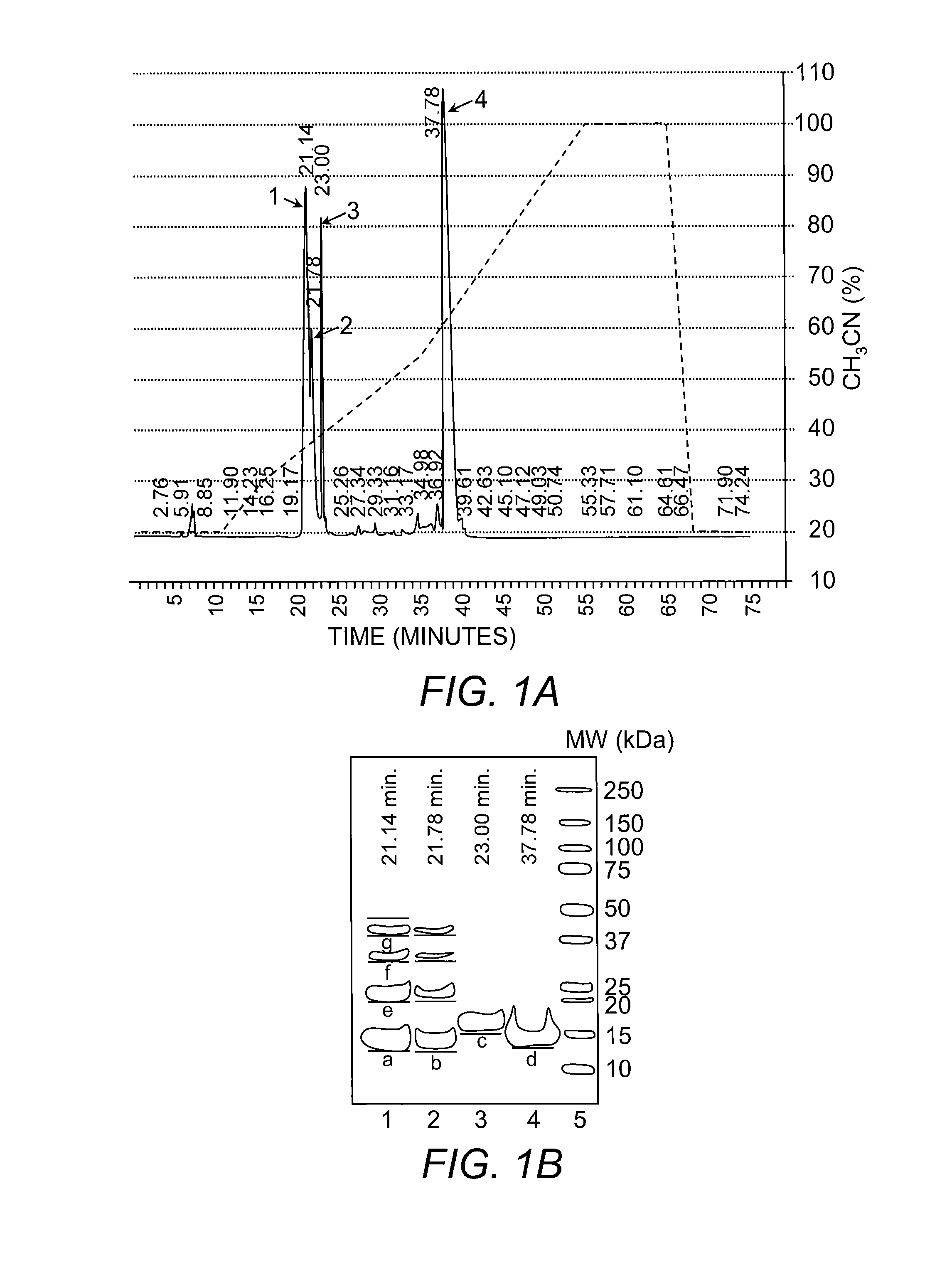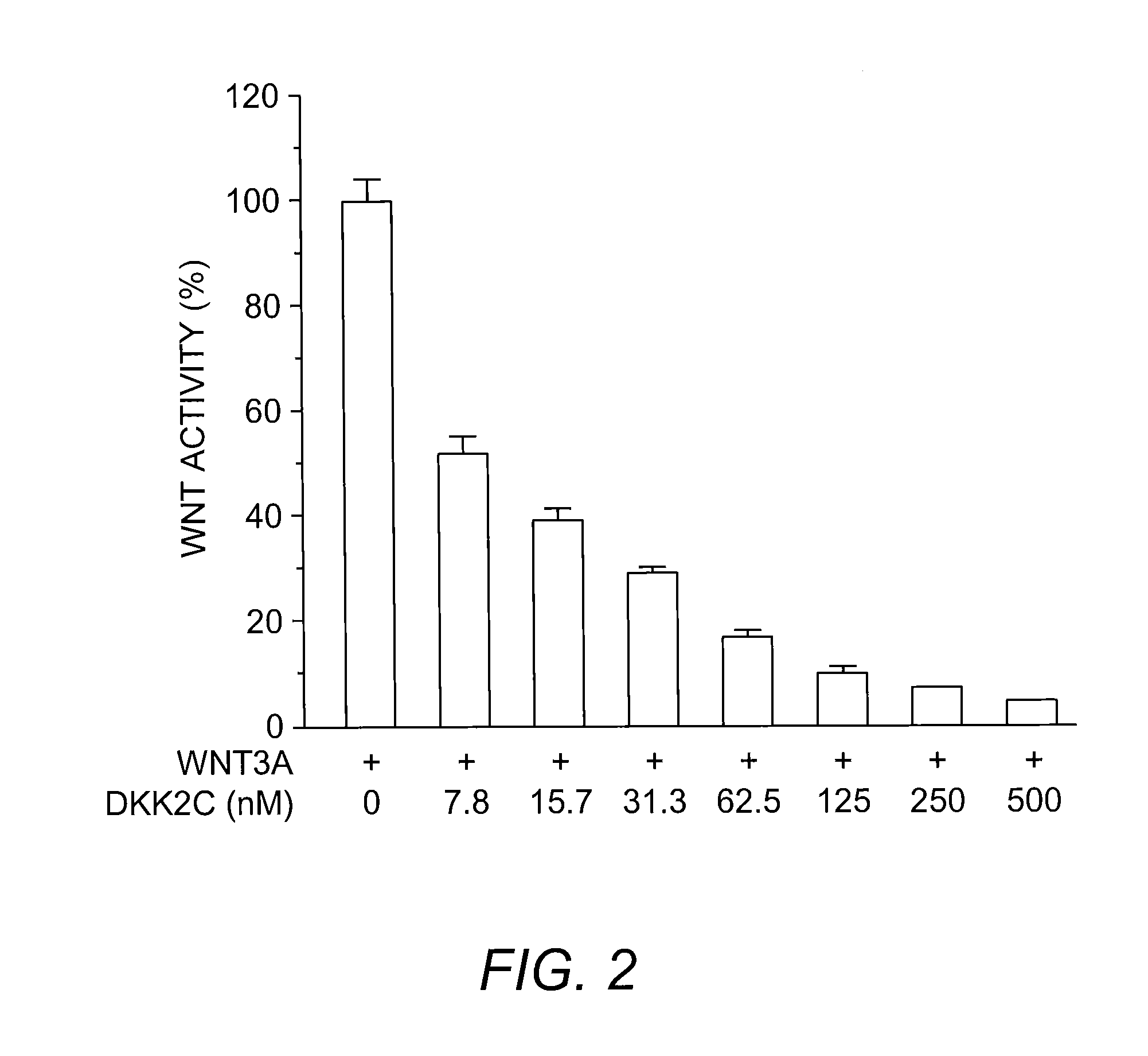Prokaryotic Expression of Soluble, Active Dkk
a technology which is applied in the field of prokaryotic expression of soluble and active dkk, can solve the problems of difficult folding of proteins, limited yield of target proteins, and complicated dkk2
- Summary
- Abstract
- Description
- Claims
- Application Information
AI Technical Summary
Benefits of technology
Problems solved by technology
Method used
Image
Examples
example 1
Construction of Thioredoxin (Trx)-Dkk2C Expression Vector
[0045]The cDNA that encodes Dkk2C was subcloned into the pET32a vector (Novagen). The linearized pET32a vector contains NdeI and BamHI restriction sites, as well as a T7 promoter and the coding sequence for ampicillin resistance. The pET32a vector was fused with a sequence coding for the 109-amino acid thioredoxin (Trx) protein. In addition, a sequence coding for a His6-tag peptide was added to the segment coding for the C-terminal end of thioredoxin protein followed by a thrombin cleavage sequence and a sequence coding for an S-tag peptide. The cDNA of Dkk2C was inserted into pET32a vector after the S-tag addition using the NdeI and BamHI sites. Another thrombin cleavage site was then added between the S-tag coding sequence and the Dkk2C sequence in order to allow a subsequent removal of the S-tag sequence from the Dkk2C segment by treatment with thrombin. The amino acid sequence of the resultant Trx-Dkk2C fusion protein is p...
example 2
Expression of Trx-Dkk2C Fusion in ORIGAMI™ B Strains
[0047]The Trx-Dkk2C fusion expression vector was subsequently transformed into an ORIGAMI™ B strain of E. coli (Invitrogen) for protein production. ORIGAMI™ B host strains carry are derived from a lacZY mutant of BL21, which additionally contains trxB / gor mutations. The genotype of ORIGAMI™ B cells is F− ompT hsdSB(rB−mB−) gal dcm lacY1 ahpC gor522::Tn10 trxB (KanR, TetR). Cells were grown in Luria-Bertani media with shaking at 220 rpm at 37° C. Protein expression was induced by the addition of 0.2 mM isopropyl-1-thio-β-D-galactoside (IPTG) when cells were at about mid-log phase (OD600 nm approximately 0.5) and the culture was shifted to 16° C. after IPTG addition and incubated for an additional 16 hours. SDS-PAGE (sodium dodecyl sulfate polyacrylamide gel electrophoresis) was used to verify protein expression: 1 ml aliquots of cell cultures were removed just before IPTG induction and at 16 hours post-induction. Cells were centrifu...
example 3
His-Tag Purification of Trx-Dkk2C
[0049]Either of the His-Tag or the S-tag affinity peptides could be used for an initial purification of the fusion protein. By way of illustration, the His-Tag was used with Immobilized Metal Affinity Chromatography (IMAC). Purification was carried out by incubating the cell lysates of Example 2 with Ni-NTA charged resin (Invitrogen, Carlsbad, Calif.) and gentle agitation for 5 hours at 4° C., thereby allowing the His6-region of the Trx-Dkk2C protein to bind to the Ni-NTA. After this incubation step, the Trx-Dkk2C fusion-charged beads were transferred into a column and washed with elution buffer (25 mM Bis-Tris, pH 6.8, 500 mM NaCl, 5 mM MgCl2, and 2% Glycerol) containing gradually increasing concentration of imidazole. Elution fractions were collected and characterized by SDS-PAGE. Although there was elution of a variety of proteins with the low imidazole washes (20 and 50 mM), the majority of the Trx-Dkk2C fusion protein was eluted from the column ...
PUM
| Property | Measurement | Unit |
|---|---|---|
| Solubility (mass) | aaaaa | aaaaa |
| Solubilization enthalpy | aaaaa | aaaaa |
Abstract
Description
Claims
Application Information
 Login to View More
Login to View More - R&D
- Intellectual Property
- Life Sciences
- Materials
- Tech Scout
- Unparalleled Data Quality
- Higher Quality Content
- 60% Fewer Hallucinations
Browse by: Latest US Patents, China's latest patents, Technical Efficacy Thesaurus, Application Domain, Technology Topic, Popular Technical Reports.
© 2025 PatSnap. All rights reserved.Legal|Privacy policy|Modern Slavery Act Transparency Statement|Sitemap|About US| Contact US: help@patsnap.com


